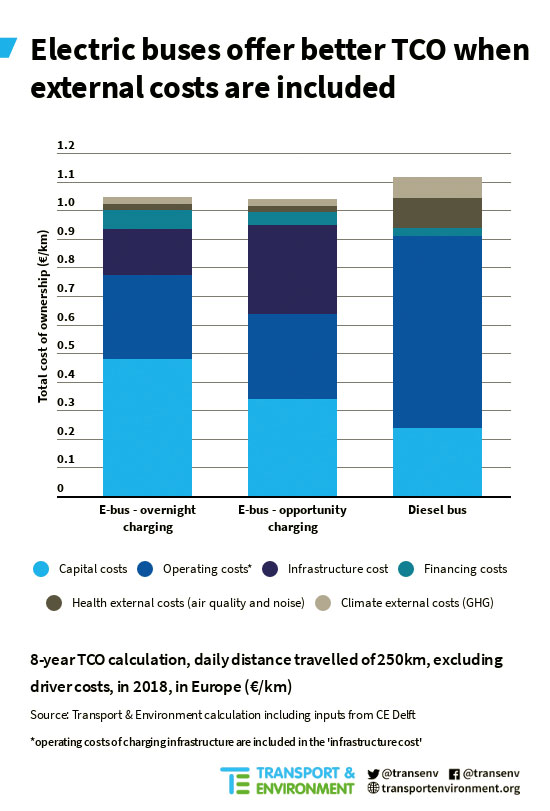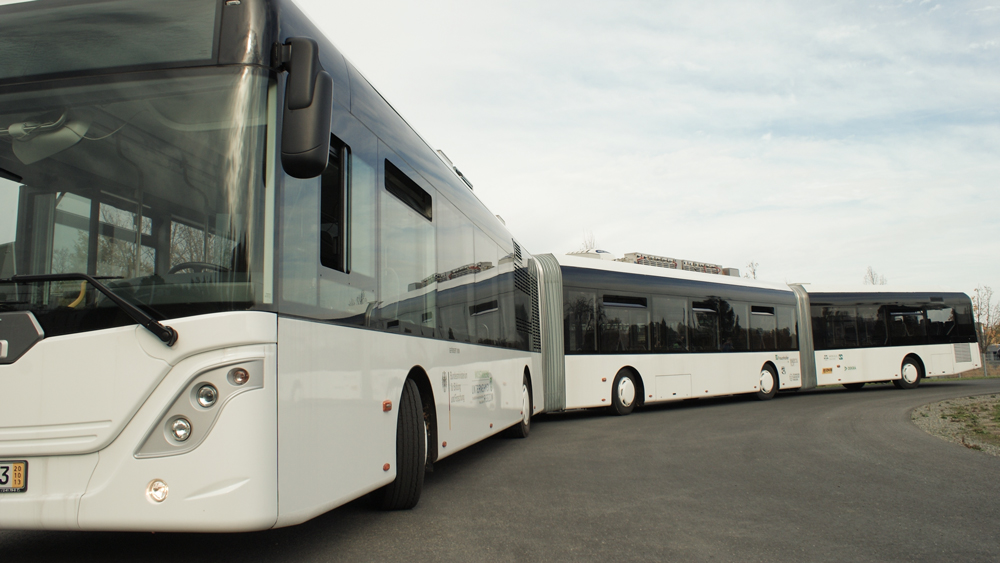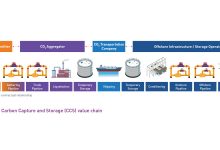European cities towards Vision Zero Pollution
Fifth of new buses to be zero emissions by 2030 in Romania
On February 11, the Members of the European Parliament and the EU Member State representatives inked an agreement on green public procurement rules for new buses. According to this deal, at least a quarter of new buses purchased by public authorities in cities across Europe will have to be ‘clean’ by 2025, and at least a third by 2030.
Europe is set to start cleaning up its public buses in the coming decade after EU lawmakers agreed binding targets for the procurement of zero-emission vehicles by local authorities and public companies, Transport & Environment informs. More than 75% of buses are publicly procured, and negotiators agreed that at least a quarter of these will have to be clean buses in 2025, and at least a third in 2030, under the revised Clean Vehicles Directive.
National public procurement targets for clean buses will range from 24% to 45% in 2025, and from 33% and 66% in 2030 – depending on a country’s population and GDP. Half of these targets will have to be achieved by procuring zero-emission buses, which means that in Germany and Sweden, for example, almost a quarter of new public buses should be zero emissions by 2025. Romania and others will see more gradual growth: almost a fifth of new public buses should be zero emissions by 2030.
“Thanks to this law, we should start to see much more electric buses being rolled out on Europe’s roads. But this directive is the bare minimum and a much faster uptake is needed. For citizens, that means cleaner air, less noise and more comfortable bus journeys. For EU bus-makers, such as Solaris and VDL, it brings new market opportunities,” Yoann Le Petit, clean vehicles officer at green transport NGO Transport & Environment (T&E), said.
The article continues below the graph.

However, the other half of the targets can be met with so-called ‘clean’ buses which, as defined under the Alternative Fuels Infrastructure Directive, can be powered by fossil fuels such as liquified and compressed natural gas.
“Counting fossil-fuelled buses as ‘clean’ is not in line with the Paris climate goals or the EU’s aim of decarbonising by 2050. Public money should not be wasted subsidising obsolete gas trucks and buses. By 2030, only zero-emission technologies should be supported with public funds,” Yoann Le Petit concluded.
Waste collection trucks and other heavy-duty vehicles procured by public authorities will also have to run cleaner: between 6% and 10% of new trucks in 2025, and 7% and 15% in 2030, will have to be low or zero-emissions. This will complement the move to cleaner trucks expected to result from CO2 standards for heavy-duty vehicles, which could be finalised this week by EU lawmakers.
Local authorities and public companies will also have to procure cleaner cars and vans: between 18.7% and 38.5% of new light-duty vehicles. These are defined in 2025 as cars or vans emitting less than 50 grams of CO2 per km – as in the revised car CO2 regulation – and, in 2030, as cars and vans with zero emissions.
Clean Vehicles Directive
The Directive on the Promotion of Clean and Energy Efficient Road Transport Vehicles aims at a broad market introduction of environmentally-friendly vehicles. It requires that energy and environmental impacts linked to the operation of vehicles over their whole lifetime are taken into account in all purchases of road transport vehicles, as covered by the public procurement Directives and the public service Regulation.
If the impacts are monetised for inclusion in the purchasing decision, common rules shall be followed for calculating the lifetime costs linked to the operation of vehicles. These rules are defined in the Directive.
‘Vision Zero’ – no pollution in action
General Statistics on Transport in the EU economy – latest statistics released in 2018 (referring to 2016)
- Transport represents 9% of EU Gross Value Added.
- Responsible for 20 million direct jobs – 9% of total EU employment
- 2.1 million companies involved in transport.
- The EU exported motor vehicles, rail rolling stock, planes and ships of a total value of EUR 295 billion. This represents 17% of the EU’s total goods exports in 2016. The EU exported transport services worth EUR 146 billion, which represents 17% of the EU’s total service exports.
- The number of passengers in the EU increased by 3.2% (2016 vs 2015), reaching 423 million passengers travelling by rail, 973 million by air, 397 million by sea.
- Freight transport increased by 4.5% (2016 vs 2015) reaching 3 661 billion tkm.
- EU Transport total investment in 2018 amounted to EUR 20.3 billion.
One in ten urban buses sold in Europe fully electric
According to an analysis published by Transport & Environment (T&E) in November 2018, just one in ten urban buses sold in Europe is fully electric.
Fully electric buses only account for 9% of urban bus sales in Europe – despite being cost competitive with diesel buses when the costs of air pollution and noise are taken into account. The new analysis of urban buses by T&E focusing on orders received by bus-makers and the total cost of ownership of different bus types.
More than 95% of the urban area in the EU is affected by air pollution with much of it caused by diesel fumes. Diesel buses impose heavy costs on society and the climate through air pollution, noise and greenhouse gas (GHG) emissions. Cleaning up the bus fleet, which is almost all diesel today, can contribute significantly to lessen the air pollution crisis in European cities.
Electric and diesel buses are already at parity in terms of total cost of ownership (TCO) when the health costs imposed by air and noise pollution are included. Add climate costs, and electric buses have today a lower TCO than diesel buses.
“Electric buses are the superior choice in every respect now. They have no tailpipe emissions, they’re quiet, comfortable and economical. If mayors and regions are serious about tackling the air quality and climate crises, the only rational decision is to buy electric buses from now on,” Lucien Mathieu, transport and e-mobility analyst at T&E, said.
Two key barriers to the electrification of buses in Europe
According to the analysis there are two key barriers to the electrification of buses in Europe.
- First challenge is the higher upfront cost (up to twice the price of a diesel bus), which makes it difficult to buy electric buses without some financial help, in particular for less wealthy cities which are usually the ones with the worst air quality.
- The second barrier is the lack of strong policy support that stimulates both supply and demand, thereby increasing economies of scale, and pushing down the cost of zero-emission buses.
“For cities struggling with the higher capital cost of zero-emission buses, a grant could be made available through the new EU budget from 2020. To further drive down the purchase price of e-buses, we need a Europe-wide zero emission sales target for new buses,” Lucien Mathieu concluded.







